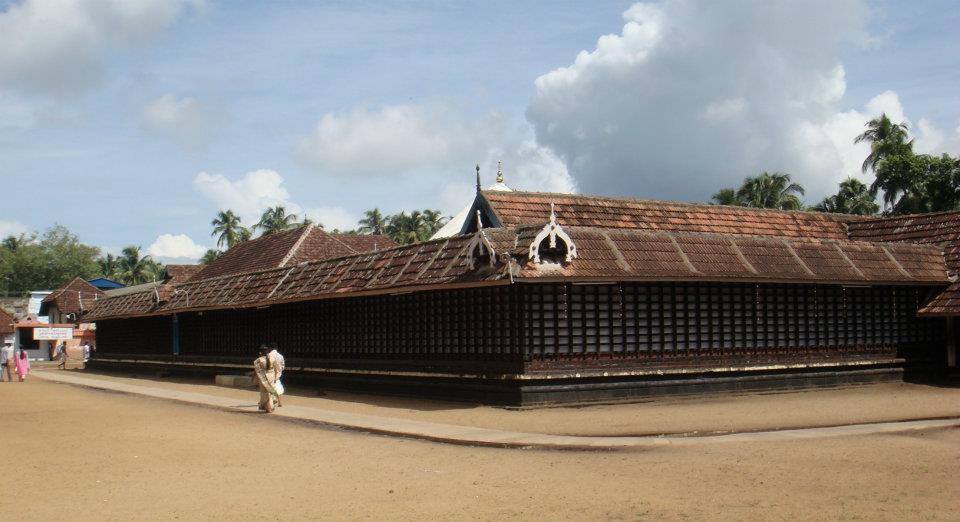Historical Triprayar Temple, located in Thrissur
district is one of the important temples dedicated to Lord Rama. Triprayar
temple is located 22 kms south west of Thrissur in between Kodungalloor and
Guruvayoor in the mid landmass of Chettuva. The temple is situated on the bank
of river Theevra. Theevra river is also called Purayar. Hence this place got
the name Thirupurayar (sacred river) and later became Triprayar. There is an
interesting legend about the origin of this river. Lord Mahavishnu during his
Vamana incarnation visited this place while going to Thrikkakkara and he found
no water to wash his legs as the whole place was dry and desolate. Vamana took
the water from his kamandalu (a small round vessel used by hindu sages to carry
water) and poured the water to wash his legs, that source of water never went
dry but kept on flowing as the Thiru Purayar or the Thriprayar (river of divine
source) as it is called now. Purayar is also called Nandiyar.

Out of the four idols discovered by fisher men, the Sree Rama
idol was the most important. Vakkayil Kaimal decided to install it in
Triprayar. It is said that when the image of Rama was discovered and was about
to be consecrated, it was divinely ordained that a peacock would appear and
mark the exact time for installation. Kaimal and his men waited for a long time
for the peacock but it didn't appeared. Apparently the Tanthri (chief priest)
installed the idol when a devotee bearing peacock feathers appeared. Soon after
the installation the peacock appeared in front of the Sreekovil. It is said
that the priests and Kaimal regretted their decision later and to make up for
this deficiency the sacrificial stone or the valiya balikkallu was installed at
the spot marked by the peacock. Hence the balikkal is said to have the same
importance as the deity itself. But this sacrificial stone showed a tendency to
spin on its axis. It was Naranathu Bhranthan who fixed it at the spot by
hammering a nail through it amidst the chanting of mantras. A mark of a nail
can still be seen gives credence to this belief.
In order to prevent any decline in the power of the idol on account of the
change in its location Naranathu Bhranthan also arranged to install two
goddesses on either side of the deity-Sree Devi on the right and Bhumi Devi on
the left. Another legend says that it was Vilwamangalm Swamiyar who is
associated with several temples of Kerala, installed the Sree Devi and Bhumi
Devi images and shut the Western doors of the temple. One day Swamiyar reached
this temple and offered prayers to Lord Rama. During his pooja he noticed that
Sree Devi and Bhumi Devi were entering the temple from the western gateway to
offer prayers to the Lord. In order to set right the fault in location of the
idol he requested them to stay inside the sreekovil. The Goddesses agreed and
later Swamiyar installed Sree Devi and Bhumi Devi idols on either side of Rama.
He then closed the western doors and left the temple. The western doors of the
temple remain shut even today.
The image of Rama (Triprayar Thevar) resembles the Chaturbhuja
Vishnu form with four arms, bearing a conch(Panchajanya), a disc (Sudarsana), a
bow (Kodanda) and a garland respectively. It is believed that the deity
worshipped here possesses some of the aspects of Shiva too. It was after
killing the asura, Khara that Sri Rama got both the Shaiva and Vaishnava
aspects. Thus Triprayar Thevar is also called Khara Samhara Moorthy. It is also
believed that the portrayal of Rama with a garland held in the image's hand is
also suggestive of aspects of Bhrahma and hence the deity is said to be a
manifestation of the Trimoorthis. The image is adorned with necklaces and other
fine jewelry. Images of Sreedevi and Bhudevi are on either side. There is an
image of Dakshinamoorthy, in the sanctum facing the south. Dakshinamoorthy is
commonly found in Shiva temples. There is also a lamp behind the image which is
kept burning all the time. Because of these and also because of the fact that
people got relief when troubled by evil spirits chathan-the deity is believed
to have a Shiva aspect also.
Ganapathy prathishta is located at the south west corner of the sreekovil.
Though there is no separate idol for Rama's best devotee Hanuman, it is
believed that his presence is always there at the Namaskara mandapam of the
temple. Devotees generally bow before the mandapa imagining the presence of
Hanuman there before worshipping Sree Rama. The offering of flattened rice
(avil) made from dried paddy is meant for Hanuman. Near the main temple towards
the north there is a small shrine of Gosala Krishna. Outside the temple in the
southern side of the courtyard there is an Ayyappa (Shastha) shrine. It is
believed that the Shastha shrine was located originally at the site
corresponding to the temple's sreekovil. With the arrival of Sree Rama, Ayyappa
moved to the south in the present location. Now Thriprayar Thevar is the
presiding deity of the Arattupuzha Pooram, one of the important festivals of
central Kerala. Lord Ayyappa of this temple also participated in this pooram
before the installation of Lord Rama. Except Triprayar Thevar, all other
participants in this pooram are Sasthas and Bhagavathys of different temples.
This also points to the conversion of Shastha shrine to Rama shrine.








